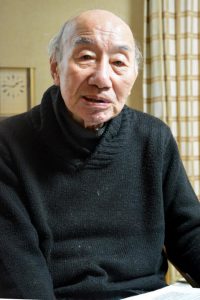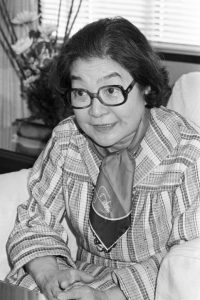Striving to fill voids in Hiroshima, unfinished judgment, Part 11: Three judges
May 3, 2024
Determination to not avoid verdict on illegality
In March 1963, the “A-bomb trial” concluded nearly eight years after the lawsuit was first filed. Three judges overseeing the case consulted with each other to make the determination about how to write the verdict. The three judges were Toshimasa Koseki, the presiding judge of the Tokyo District Court who died in 2009 at the age of 96; Yoshiko Mibuchi, who died in 1984 at the age of 69; and Akira Takakuwa, now 87 and living in Tokyo.
Mr. Takakuwa sensed the weight of the social and political impact resulting from the verdict. “Although a civil case, it was a decision by a state institution. Besides, the institution would judge the validity of the atomic bombings by the United States, a victor in the war, on the basis of international law. In short, it was a major event. We believed we needed to approach the case with a resolute mindset,” recalled Mr. Takakuwa.
Three judges were “confident”
The plaintiffs sought damages from the Japanese government, which had waived its right to make claims against the United States, based on the argument that the atomic bombings had violated international law. Formally, it was a lawsuit for damages, and the option did exist for the judges to simply issue their response to the demand for damages and pass on judging whether or not the atomic bombings were illegal.
However, Mr. Koseki’s determination was unbending. In a later interview with the Chugoku Shimbun dated December 29, 1967, he said, “The plaintiffs wanted a decision on whether or not the atomic bombings were illegal. And as a judge, I felt we should not avoid that issue.”
According to Mr. Takakuwa, after reviewing the opinions of international law experts, the judges were “confident” they could make the ruling that the atomic bombings of Hiroshima and Nagasaki were a violation of international law. Mr. Takakuwa wrote a draft of the decision, and the other judges read the document and added their revisions.
Impressions also incorporated
Ms. Mibuchi, a pioneer in women’s legal circles and the model for the heroine in the series “Tora ni Tsubasa” (in English, “The Tiger and Her Wings”) currently being broadcast on NHK (Japan Broadcasting Corporation), lost her husband in the war, when he was drafted into the military and died of a disease contracted at the war front. The judges’ impressions and opinions about the war waged by the state and on measures for relief to victims of the war were also incorporated into the decision.
Ms. Mibuchi wrote in personal notes before her death that, “Judges hand down decisions they believe to be right according to their conscience, with nothing other than the law compelling a decision.”
On the other hand, Yasuhiro Matsui, the attorney for the plaintiffs, had mixed feelings of hope and apprehension. After the trial had concluded, he wrote a letter to those involved. “I think we were able to prove that the use of the atomic bombs was a violation of international law, and if that’s the case, I have fulfilled Mr. Okamoto's wishes. But even so I can't be optimistic.”
Shoichi Okamoto, a proponent of the lawsuit, died three years after it was filed. Following Mr. Okamoto’s death, Mr. Matsui did the work of filing papers and conducting oral arguments on his own, driven in part by his younger brother's horrific experience in the atomic bombing of Hiroshima.
Mr. Okamoto and the victims on the plaintiffs’ side hoped that a first court ruling in the world judging that the atomic bombings had violated international law could be used to effect a comprehensive ban on nuclear weapons. The day was approaching when the question of whether a verdict would respond to their wishes would be answered.
The final verdict was scheduled to be delivered on December 7, 1963.
(Originally published on May 3, 2024)









